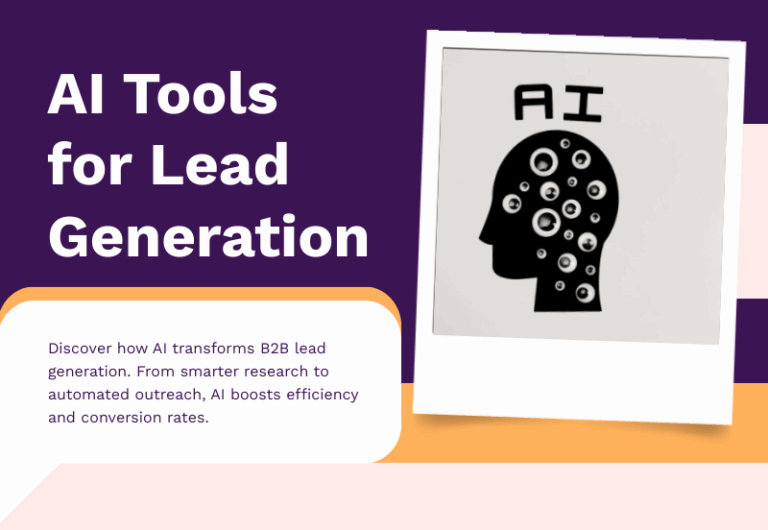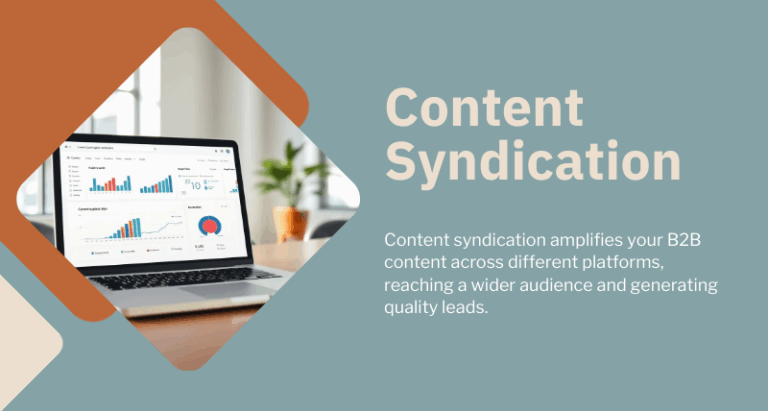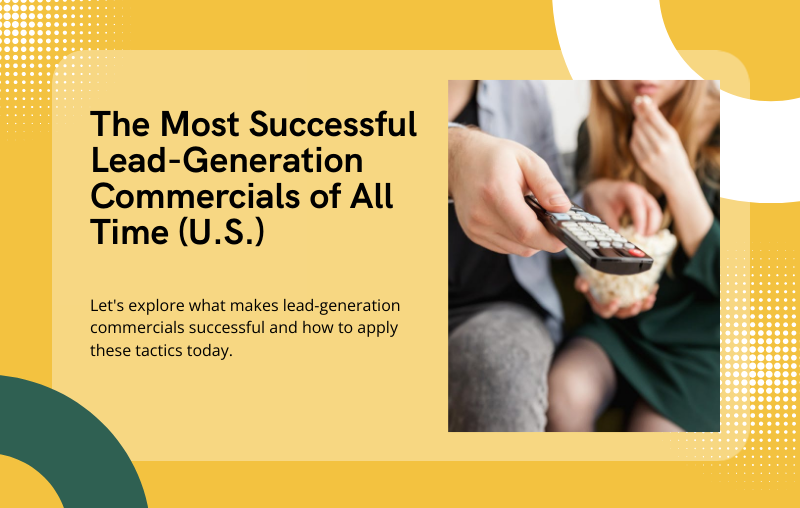
The most successful U.S. lead-generation commercials made a specific promise to a narrow audience, delivered a simple proof point in seconds, and provided a frictionless path to respond—by phone, URL, or text—so the handoff from attention to action was instant. For operators, the playbook is replicable: tighten the offer, make response obvious, and measure downstream quality, not just volume.
Executives don’t need a history lesson on TV ads. What you need is a pattern you can lift and reuse. This piece reverse-engineers America’s most effective lead-gen spots—what they promised, why they converted, and how you can adapt the mechanics for today’s streaming, CTV, and mobile journeys.
What Counts as “Success” in Lead-Gen Advertising
Success isn’t fame—it’s efficient, qualified demand. The best commercials compress time-to-response, lower cost per qualified lead, and sustain conversion to revenue over many flights, not one-off spikes.
Operationally, the yardstick is simple:
• Time-to-response: seconds from impression to call, click, or text.
• Cost per qualified lead (CPQL): not just CPL; measure post-screening quality.
• Conversion to sale: close rates from commercial-sourced leads versus baseline.
• Continuity value: recurring revenue, upsells, or continuity programs that compound ROI.
• Durability: repeatable performance across weeks, stations, and creative refreshes.
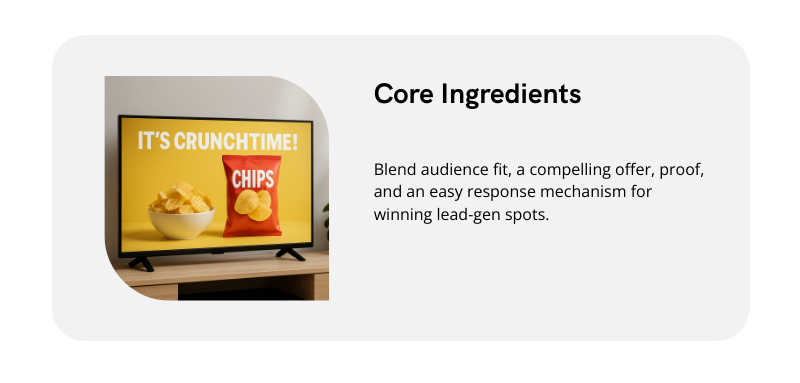
Core Ingredients of High-Performing Lead-Gen Spots
The winning formula blends four elements—tight audience/problem fit, a single compelling offer, ritualized proof, and an unmistakable call to action with an easy response mechanism.
- Specific audience, specific pain
Great lead-gen ads speak to one high-intent moment (e.g., “struggling with acne before a big event,” “need cash from a structured settlement,” “want an at-home fitness reset”). - One offer, one path
No split attention. The entire creative orbits one promise and one action: “Call this number,” “Go to this URL,” or “Scan now.” - Proof you can feel
Proof is fast and visceral: a before/after, a social demonstration, or a credibility shortcut (expert/celebrity with authentic testimony). - Frictionless response
Memorable vanity numbers and jingles, short URLs, and on-screen repetition lower recall friction and spike response curves.
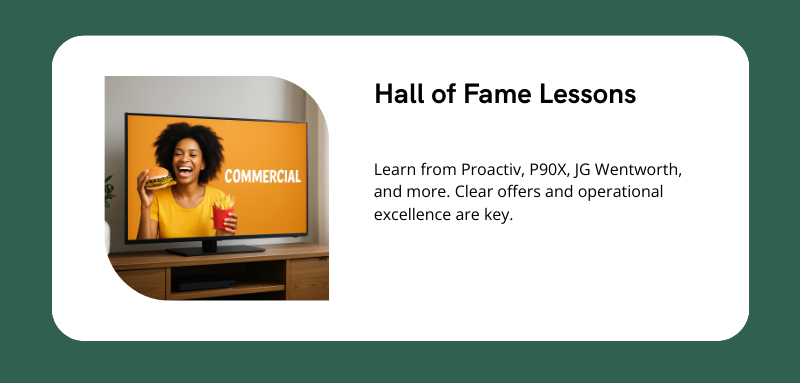
The Hall of Fame: U.S. Lead-Gen Commercials That Rewrote the Playbook
Proactiv: The Continuity Engine
Proactiv built a continuity machine with celebrity-driven credibility, clear regimen storytelling, and a recurring subscription path. The commercial wasn’t just selling a kit; it was selling a future identity and a relationship.
Why it worked:
• Narrow pain, high urgency: acne undermines confidence; desire for fast, visible progress is acute.
• Proof ritual: celebrity before/after arcs and day-by-day routines framed as a simple, three-step system.
• Continuity by design: the commercial pushed kit enrollment with automatic shipments and “just in time” replenishment, maximizing lifetime value.
• Omnichannel memory: the brand’s recurring celebrity roster made the message unavoidable and credible to teens and parents, while phone and web ordering lowered friction.
Operator takeaway
If your category has recurring use, build the continuity message into the spot itself. Sell the routine, not just the product, and make enrollment the default next step.
P90X (Beachbody): Transformation as a Lead Magnet
Transformation-driven infomercials used bodies as proof, routines as process, and community as retention—turning viewers into leads ready to enroll in a system, not a one-time purchase.
Why it worked:
• High-stakes promise: visible transformation in a defined timeframe.
• Relentless proof: “before/after” walls, authentic testimonials, and program structure.
• Behavioral design: calendars, meal plans, and progress tracking convert curiosity into commitment.
• Offer clarity: trial pricing, bundles, and phone/URL options remove purchase hesitancy.
Operator takeaway
When your value proposition is behavioral change, put the system front and center. Pair dramatic proof with step-by-step scaffolding and a clear “start today” path.
J.G. Wentworth: The Jingle That Became a Funnel
A repetitive operatic jingle etched a phone number into memory and linked it to a single urgent problem—turning brand recall into inbound calls at scale.
Why it worked
• Memory hack: the melodic phone number repetition created effortless recall.
• Problem-offer lock: “structured settlement” pain + “need cash now” urgency + obvious response path.
• Timing agnostic: the ad worked whether the need was instant or latent; the number stuck until the moment of need.
Operator takeaway
If your funnel begins with a conversation, don’t bury your call number—make it the hook. Repetition isn’t a creative flaw in DR; it’s the mechanism.
FreeCreditReport.com: Entertainment as Lead Capture
Catchy, narrative mini-songs turned a dull category (credit monitoring) into sing-along stories, with a URL embedded in the chorus so the “what to do next” was inseparable from the tune.
Why it worked
• Category contrast: humor and music in a serious space created pattern break.
• URL as lyric: response path was literally the chorus, compressing recall friction.
• Relatable micro-plots: each spot dramatized a financial regret that the service could help avoid.
Operator takeaway
If your URL is your lead gate, write it into the script as a rhythmic element. Make the action path unforgettable by design, not a fine-print afterthought.
HeadOn: Repetition, Minimalism, and Ubiquity
Extreme simplicity and relentless frequency made an otherwise opaque product impossible to ignore. The ad became a meme—and a prompt to test the product.
Why it worked
• Radical clarity: a single line, repeated.
• Heavy rotation: frequency made audiences curious enough to respond.
• Retail follow-through: simple in-store discovery closed the loop for impulse trial.
Operator takeaway
When your goal is fast awareness with a low-commitment trial, extreme simplicity plus frequency can outperform cleverness. But ensure distribution is ready before you scale.
1-800 Contacts: Convenience as the Value Proposition
Rather than sell lenses, the spots sold “skip the hassle”—same brands, fast delivery, and human help. A memorable phone number and direct promise reduced friction for an errand nobody enjoys.
Why it worked
• Clear job-to-be-done: reorder without paying extra or making a trip.
• Humanized proof: everyday customer stories reframed the category as service, not product.
• Dual response path: phone for talkers, web/app for digital natives—both equally prominent.
Operator takeaway
If your advantage is convenience, script the pain you remove and give two equivalent response options to capture both call-in and click-in demand.
Education Connection: The “Match Me” Hook
Simple, rhythmic jingles embedded the core action—“get matched for free”—making the ad both mnemonic and directive for adults considering school.
Why it worked
• Clear exchange: “We do the matching, you pay nothing.”
• Rhythmic CTA: the action is the chorus.
• Mid-funnel intent capture: targets people already contemplating upskilling but stalled by choice overload.
Operator takeaway
In high-choice categories, sell the reduction of complexity, not the catalog. A “matching” promise plus zero-cost positioning pulls fence-sitters into your funnel.
Senior Insurance & Medicare Lead-Gen Spots: (Format, Not Endorsement)
Senior-focused commercials with recognizable spokespeople push phone-first response for plan comparisons or final-expense quotes, converting TV attention into consultative calls.
Why it worked (mechanically)
• Trusted faces and plain-language offers reduce perceived risk.
• Immediate phone CTA fits the demo’s channel preference.
• Strong incentive framing (benefits checks, low fixed pricing) prompts inbound interest.
Operator takeaway
If your conversion hinges on counseling, architect the spot around an immediate, toll-free call—then staff for call-answer SLAs, needs assessment, and compliance guardrails.
Common Patterns Across Winners
Three patterns recur—response is the creative, proof is immediate, and follow-through is operationally excellent. Production quality matters less than clarity, credibility, and continuity.
- Response is the hero
The vanity number, URL, or code isn’t a tag—it’s the hook. The entire ad teaches the audience how to respond. - Fast, relatable proof
Before/after visuals, credible spokespeople, or social demonstration compress the belief gap. Proof arrives in seconds, not minutes. - Continuity and ops discipline
The best spots fail without back-end rigor: staffed call centers, fast fulfillment, proactive follow-ups, and continuity billing where appropriate.
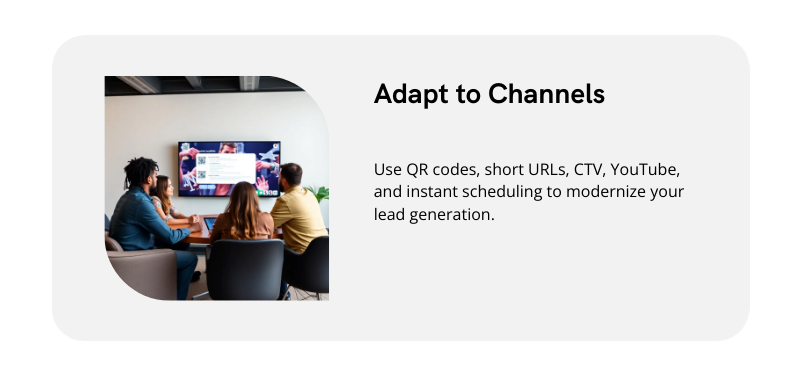
How to Adapt the Classics to Today’s Channels
The creative mechanics remain the same; distribution changes. Translate vanity numbers to short URLs and scannable codes, shift media to CTV and YouTube, and close the loop with instant scheduling or lead routing.
- CTV and streaming
• Treat QR codes like vanity numbers—on-screen long enough to scan.
• Map audiences by intent segments (in-market, life-event, lapsed users).
• Run daypart tests: early morning and late evening can be DR gold depending on audience. - Mobile handoffs
• Deep-link to prefilled forms, not your homepage.
• Offer tap-to-call and tap-to-text side-by-side.
• Add “save for later” via email or calendar reminder to reduce drop-off. - Social video remix
• Cut 6-, 15-, and 30-second edits that keep the offer and CTA intact.
• Pin the offer in captions and on-screen text; consistency beats novelty.
• Retarget viewers who watched 50%+ with a direct form or appointment CTA.
Measurement Framework for Operators
Judge success across three horizons—immediate response, qualified pipeline, and revenue contribution. Invest where CPQL and LTV/CAC ratios persist over time.
• Immediate: response rate by creative, station, daypart, and spot length.
• Mid-funnel: qualified rate, show rate for scheduled calls, and cost per scheduled consult.
• Downstream: close rate, average order value, continuity retention, and LTV/CAC.
• Durability: how long a creative sustains performance before fatigue; plan refresh cadence.
Creative Blueprint You Can Reuse
Define the offer in one line:
• “[Audience] who [pain] can get [specific outcome] in [timeframe/effort]—call [number] or visit [URL] now.”
Script spine (30 seconds):
• 0–5s: Name the pain in the viewer’s words.
• 5–12s: Show visceral proof (before/after, demo, social validation).
• 12–20s: State the promise and what’s included.
• 20–27s: Repeat the offer and the action path slowly on-screen.
• 27–30s: Visual mnemonic (phone number jingle, QR stare-down, short URL).
On-screen design rules:
• CTA stays visible at least 50% of the runtime.
• Phone number or URL appears in large, high-contrast type; never crowded.
• If using QR, give a three-second “hold” while VO repeats the benefit.
Operational Checklist for Lead Quality (Not Just Volume):
Ads create interest; ops creates outcomes. Staff for speed, screen for fit, and respect compliance.
• Answer speed: 80% of calls answered within 20 seconds.
• Qualification: scripted questions that identify need, authority, timeline, and budget.
• Next step: schedule the consult on the call; never “we’ll email you later.”
• Compliance: recordkeeping, opt-in consent, and clear disclosures.
• Feedback loop: return call outcomes to media buying for creative and placement optimization.
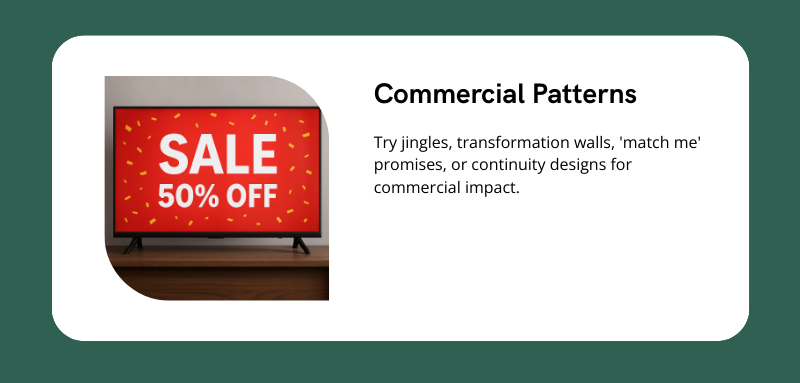
Mini Commercial Patterns to Borrow
The Jingle Memory Hook
Use a melodic line to repeat your number or URL. Keep syllables simple, repeat at least three times, and land on the CTA. This is ideal for phone-first funnels and demo groups comfortable calling.
Transformation Walls
When selling change (fitness, finance, habit), stack social proof in seconds: quick-cut testimonials, visible before/after evidence, and a calendar that shows the journey viewers can step into today.
The “Match Me” Promise
In high-complexity categories (education, financial plans, B2B tooling), sell the reduction of choice. Your offer is the concierge: “Tell us your constraints; we’ll shortlist and guide you—free.”
Continuity by Design
If your margins require repeat use, make replenishment or membership the default. The commercial should answer, “What happens after I say yes?” with a simple, valuable routine.
Compliance-Forward DR
In regulated categories, earn trust by speaking plainly, disclosing clearly, and referencing the role you play (e.g., agency vs. carrier). The fastest way to scale is to never backpedal on compliance.
Modern Variations that Preserve the DR Soul
You can keep the DNA of the classics and modernize the wrapper—QR codes, instant scheduling, and first-party data make spots smarter without sacrificing clarity.
• Replace vanity numbers with short, pronounceable URLs that mirror your brand.
• Add QR codes that drop viewers onto prefilled forms; autoload UTM parameters for attribution.
• Offer “call me now” callbacks inside the landing experience to recover dropped calls.
• Use first-party lead routing to push hot leads to live agents in under two minutes.
Building Your Own “Hall of Fame” Spot: A Practical Playbook
Pick one core promise, script to proof, and operationalize response. Then iterate by data, not opinion.
- Promise selection
Write three versions of your core promise. Pressure-test each against specificity, credibility, and speed to value. Pick the one a skeptical operator would approve. - Script and storyboard
Assemble VO, visuals, and on-screen text around the five-beat spine. Proof must appear by second seven. The CTA—number, URL, or QR—should never be absent for more than five seconds. - Landing and call design
Mirror the creative on the landing page and in call scripts. If the ad says “free matching,” your form and agent openers must use those exact words. - Media and measurement
Pilot across two dayparts and at least three networks or streaming inventory sources. Set holdout groups and creative A/Bs. Report daily on response and weekly on CPQL and conversion. - Refresh cadence
Expect six to eight weeks before fatigue on high-rotation buys. Refresh creative elements while preserving the core offer and CTA consistency.
Executive Cheat Sheet
• One promise. One path. One proof.
• Make the response mechanism the star.
• Staff and script for speed; friction kills ROI.
• Measure CPQL and revenue, not just calls or clicks.
• Refresh creative on cadence—don’t reinvent the offer each time.
• In regulated categories, lead with clarity and disclosures. Scale requires trust.
The U.S. lead-gen greats weren’t just catchy—they were operationally tight. They made the response obvious and the decision safe. If you package your value into a single memorable promise, put the proof where eyes land first, and make acting effortless, your commercials will generate not just leads—but qualified, revenue-bearing demand.
